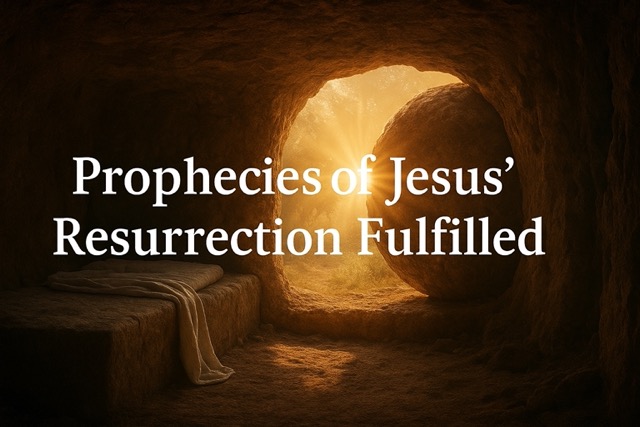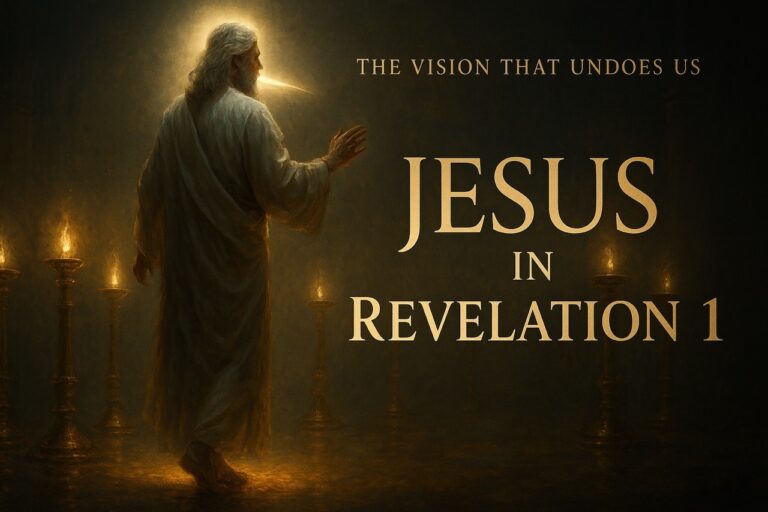The prophecies of Jesus’ resurrection reveal that His victory over death was no surprise — it was foretold long before the empty tomb was found. Long before the tomb was found empty, the Old Testament whispered of life rising from the grave — through Psalms, prophets, and sacred patterns embedded in Scripture. These prophecies foretold not only Christ’s return from death, but His glorious ascension to the right hand of God.
The prophecies of Jesus’ resurrection are more than scattered verses — they form a divine thread woven through Israel’s story. From Psalm 16:10 (“You will not let Your Holy One see decay”) to Hosea 6:2 (“on the third day He will raise us up”), the Hebrew Bible points ahead to a Messiah who would conquer death itself.
Jesus fulfilled these ancient promises in stunning detail. As Peter declared in Acts 2:24–32, the resurrection was not a last-minute miracle — it was the plan from the beginning.
In this article, we’ll explore the key Old Testament scriptures that predicted Christ’s resurrection and ascension. We’ll trace their fulfillment in the New Testament, unpack their theological depth, and reveal how they offer hope of eternal life to all who believe.
💀 They didn’t die for a lie.
See how all of Jesus’s disciples died — and what it proves.
Want the full breakdown of fulfilled messianic prophecy?
View our master guide: 351 Prophecies Jesus Fulfilled in Scripture →
✝️ Want to go EVEN deeper?
Explore the historical evidence of Jesus through ancient writings, Roman records, and archaeological discoveries that confirm His life and crucifixion. 🔍 Read the full article →
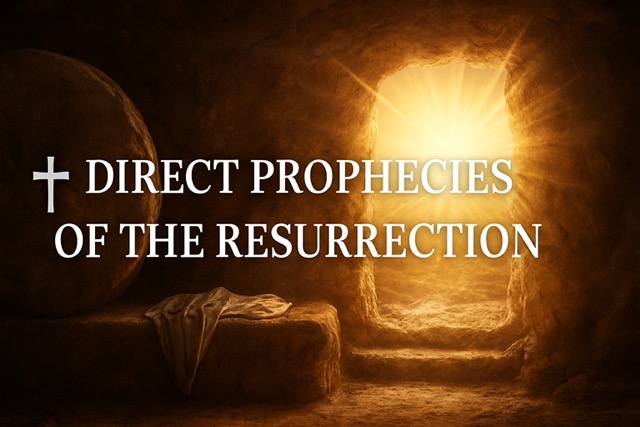
✝️ Direct Prophecies of the Resurrection
Psalm 16:10 — “You will not abandon Me to Sheol”
“For You will not leave my soul in Sheol, nor will You allow Your Holy One to see corruption.”
— Psalm 16:10
This powerful line, spoken by David, was more than poetic hope. According to Acts 2:25–32, it was a prophecy — not about David himself, but about the Messiah who would rise from the grave. Peter makes it clear: David’s body saw decay, but Jesus’ body did not. God raised Him up, fulfilling the Psalm in precise detail.
🧠 Hebrew word insight:
שָׁחַת (shachat) means “corruption” or “decay.” The prophecy implies a resurrection before physical decomposition — a miracle that occurred on the third day.
Hosea 6:2 — “On the third day He will raise us up”
“After two days He will revive us; on the third day He will raise us up, that we may live in His sight.”
— Hosea 6:2
Though often read corporately, this passage reveals a deeper prophetic pattern: revival on the third day. Early Christians saw in Hosea a foreshadowing of the resurrection timeline. Paul connects this in 1 Corinthians 15:4, declaring that “He was raised on the third day according to the Scriptures.”
🧠 Hebrew word insight:
קוּם (qum) — “to rise, to stand up.” This word reinforces the active, bodily nature of resurrection — not merely spiritual, but physical rising into life again.
Isaiah 53:10–11 — “He shall prolong His days”
“When You make His soul an offering for sin… He shall see His offspring, He shall prolong His days… and the pleasure of the Lord shall prosper in His hand.”
— Isaiah 53:10–11
How can someone die as a guilt offering, yet “see His offspring” and “prolong His days”? The only answer is resurrection. Isaiah’s Suffering Servant dies for the sins of others — but lives again to fulfill God’s plan. Jesus alone fits this paradox, rising from the grave with authority and offering new life to all.
🧠 Hebrew word insight:
חָיָה (chayah) — “to live, to be restored to life.” Isaiah points beyond death, describing a Servant who returns to life by God’s will and for God’s purpose.
Jonah 1:17 — “Three days and three nights in the belly of the fish”
“And Jonah was in the belly of the fish three days and three nights.”
— Jonah 1:17
Jesus Himself cited this as a direct prophetic sign:
“Just as Jonah was three days and three nights in the belly of the sea monster, so will the Son of Man be three days and three nights in the heart of the earth.”
— Matthew 12:40
The parallel is unmistakable. Jonah’s entrapment — and release — symbolized death and resurrection. Jesus used it as the proof sign for His own rising from the dead.

📖 Resurrection Foreshadowed in Psalms & Prophets
Psalm 2:7 — “You are My Son; today I have begotten You”
“I will declare the decree: The Lord has said to Me, ‘You are My Son, today I have begotten You.’”
— Psalm 2:7
At first glance, this verse appears to celebrate Davidic kingship. But the apostle Paul applies it directly to the resurrection of Jesus:
“God has fulfilled this for us… by raising up Jesus. As it is also written in the second Psalm: ‘You are My Son, today I have begotten You.’”
— Acts 13:33
“Begotten” here refers not to Jesus’ birth, but to His new life through resurrection — His emergence as the glorified, reigning Son of God.
Isaiah 25:8 — “He will swallow up death forever”
“He will swallow up death forever, and the Lord God will wipe away tears from all faces…”
— Isaiah 25:8
This verse offers a stunning promise: death will not have the final word. Paul quotes it in 1 Corinthians 15:54, declaring that through Jesus’ resurrection, this prophecy is already being fulfilled. Death has been defeated — not just for Jesus, but for all who trust in Him.
Isaiah 26:19 — “Your dead shall live”
“Your dead shall live; together with my dead body they shall arise. Awake and sing, you who dwell in dust!”
— Isaiah 26:19
This is one of the clearest resurrection hopes in the Old Testament. It speaks to a time when the righteous dead will rise from the dust — echoing the resurrection of Christ and the future resurrection of believers. Early Christians saw this verse as spiritually aligned with Jesus’ own bodily rising.
🧠 Hebrew word insight:
חָיָה (chayah) — “to come alive again.” The same word used in Isaiah 53:10–11 for the Servant’s post-death life appears here, reinforcing a consistent resurrection theme.
Psalm 110:1 — “Sit at My right hand”
“The Lord said to my Lord, ‘Sit at My right hand, till I make Your enemies Your footstool.’”
— Psalm 110:1
This enthronement verse, the most quoted Old Testament line in the New Testament, points to the ascension and post-resurrection glorification of Christ. Jesus cites it to confound His critics (Matthew 22:44), and Peter uses it in Acts 2:34–36 to prove that Jesus, raised from the dead, is now exalted at God’s right hand.
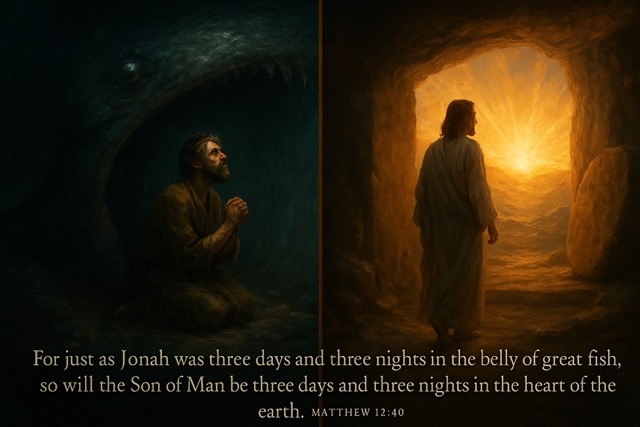
🔍 Third-Day Patterns in the Prophecies of Jesus’ Resurrection
Jonah and the Great Fish — A Living Parable of Resurrection
“For just as Jonah was three days and three nights in the belly of the great fish,
so will the Son of Man be three days and three nights in the heart of the earth.”
— Matthew 12:40
Jonah’s descent into the depths was more than a punishment — it was a prophetic sign. Swallowed alive and entombed in darkness, he cried out to God and was delivered on the third day. Jesus directly connects this moment to His own burial and resurrection. The “sign of Jonah” became one of the clearest foreshadowings of Christ’s victory over death.
Abraham and Isaac — A Father Willing to Sacrifice His Son
“Then on the third day Abraham lifted his eyes and saw the place afar off.”
— Genesis 22:4
The story of Abraham offering Isaac is saturated with messianic imagery: a beloved son, a sacrificial act, and faith in resurrection. Hebrews 11:19 even says that Abraham reasoned God could raise Isaac from the dead. And when did the moment of obedience come? On the third day — a quiet yet powerful pointer to Jesus’ resurrection after the sacrifice.
The Temple — Destroyed and Raised in Three Days
“Destroy this temple, and in three days I will raise it up.”
— John 2:19
The disciples didn’t understand it at the time, but after Jesus rose from the dead, they remembered these words. Jesus wasn’t speaking of the stone temple — He was talking about His body. The “three-day rebuild” became a bold resurrection prediction. Jesus was the true Temple, destroyed by sin and raised again by God’s power.
Together, these stories form a sacred pattern: death, darkness, and waiting… followed by life on the third day.
They teach us that the resurrection of Jesus wasn’t merely historical — it was scripturally inevitable.

🧠 Why the Prophecies of Jesus’ Resurrection Matter
Resurrection Means Victory Over Death
The resurrection is not just a return to life — it is the defeat of death itself. As Paul declares:
“Death has been swallowed up in victory.”
— 1 Corinthians 15:54
This echoes Isaiah 25:8 and transforms it from future hope to present reality. Jesus didn’t just survive death — He conquered it. He tore open the grave from within, and because He lives, we too shall live.
Resurrection Confirms Jesus as the Righteous Son
The resurrection is the Father’s seal of approval. While the cross looked like defeat, the empty tomb declared that Jesus was truly the Son of God and completely without sin. As Paul writes:
“Who through the Spirit of holiness was appointed the Son of God in power by His resurrection from the dead: Jesus Christ our Lord.”
— Romans 1:4
This vindication fulfills Psalm 2:7 — “You are My Son” — not just as a poetic phrase, but as divine declaration after resurrection power.
Resurrection Provides Justification for Believers
One of the most stunning truths in the New Testament is that our justification hinges on the resurrection:
“He was delivered over to death for our sins and was raised to life for our justification.”
— Romans 4:25
Christ’s death paid the price, but His resurrection secured the verdict. It is the divine receipt that the sacrifice was accepted, and the path to righteousness is now open.
Resurrection Foreshadows the Believer’s Future
Christ is not just the risen one — He is the firstfruits:
“But Christ has indeed been raised from the dead, the firstfruits of those who have fallen asleep.”
— 1 Corinthians 15:20
His rising guarantees that all who belong to Him will rise too. The resurrection isn’t just backward-looking; it is our preview of eternity.
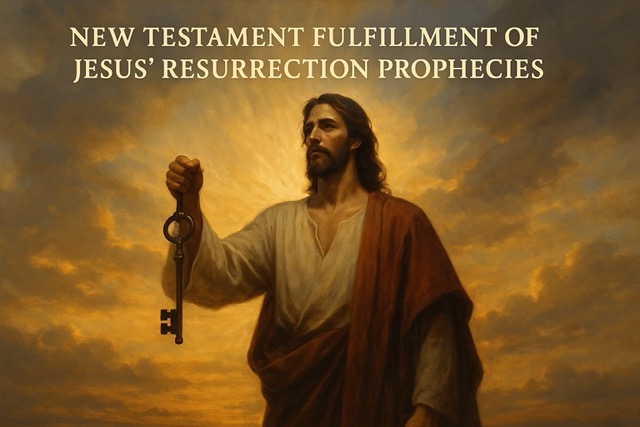
📜 New Testament Fulfillment of Jesus’ Resurrection Prophecies
Acts 2:24–32 — Peter Declares Psalm 16 Fulfilled
On the day of Pentecost, Peter stood before a crowd in Jerusalem and explained what had just happened:
“God raised Him up, having loosed the pains of death… For David says concerning Him: ‘You will not leave My soul in Hades, nor will You allow Your Holy One to see corruption.’”
— Acts 2:24–27
Peter boldly asserts that David’s words in Psalm 16:10 were not about David — they were prophetic of Jesus. He reminds them that David died, was buried, and his tomb was still visible. But Jesus? God raised Him, and the apostles were witnesses of that resurrection (v. 32).
1 Corinthians 15:3–4 — “Raised on the Third Day According to the Scriptures”
Paul delivers the gospel in its most condensed form:
“Christ died for our sins according to the Scriptures… He was buried, and He was raised on the third day according to the Scriptures.”
Though Paul doesn’t cite a single verse here, his phrase “according to the Scriptures” reflects a wide sweep — including Hosea 6:2, Jonah 1:17, and the third-day typology found throughout the Old Testament.
This resurrection was not random — it was Scripture-shaped and Spirit-confirmed.
Luke 24:44–46 — Jesus Opens Their Eyes to the Prophecies
After the resurrection, Jesus Himself confirms that the entire Old Testament pointed to His suffering and rising:
“These are the words which I spoke to you… that all things must be fulfilled which were written in the Law of Moses and the Prophets and the Psalms concerning Me… Thus it is written, and thus it was necessary for the Christ to suffer and to rise from the dead the third day.”
— Luke 24:44–46
He references all three divisions of the Hebrew Bible, teaching that resurrection was always part of God’s plan. The Scriptures were not silent about it — we were simply blind to it until Jesus made it plain.
Revelation 1:18 — “I Am Alive Forevermore”
“I am He who lives, and was dead, and behold, I am alive forevermore.”
— Revelation 1:18
The risen Christ now speaks from glory, no longer veiled in parables. His declaration affirms every prophecy — death could not hold Him. He is the living King, holding “the keys of Death and Hades.”
It is the final echo of Psalm 16 and Isaiah 25: death defeated, resurrection fulfilled, and the future secured.

✍️ Hebrew Word Studies in Resurrection Prophecy
שָׁחַת (shachat) — “Corruption, decay”
📖 Found in: Psalm 16:10
“You will not allow Your Holy One to see corruption…”
Shachat refers to physical decomposition — the decay of a dead body. This is not symbolic or metaphorical. David prophesied that the Messiah would die, yes — but His body would never rot. The resurrection would occur before decomposition set in, a remarkable detail fulfilled in Jesus’ third-day rising.
קוּם (qum) — “To rise, to stand up”
📖 Found in: Hosea 6:2
“On the third day He will raise us up…”
This verb doesn’t just mean to awaken — it means to stand again in strength. The word appears throughout the Hebrew Bible to describe physical rising, often after death or destruction. Hosea uses it to describe national revival, but the phrase is steeped in messianic overtones. Paul alludes to this passage in 1 Corinthians 15:4.
חָיָה (chayah) — “To live again, to be restored to life”
📖 Found in: Isaiah 26:19, Isaiah 53:10–11
“Your dead shall live… He shall prolong His days…”
Chayah is used to describe not just existence, but vital, restored life — especially after danger or death. In Isaiah 26, it speaks of the faithful rising from the dust. In Isaiah 53, it foretells that God’s Suffering Servant would live again after death, to “see His offspring” and complete His mission. This is resurrection language from the prophetic core.
🔗 Related Reading on ParanoidProphet.com
📜 Prophetic Foundations:
- Messianic Prophecies of Jesus the Redeemer
Explore the broader context of Jesus’ redemptive mission, including His sacrificial role foretold in Isaiah 53. - Messianic Prophecies of Jesus’ Suffering and Crucifixion
See how Jesus’ death was predicted in astonishing detail — from pierced hands to silent submission. - Prophecies About Jesus’ Ministry
Discover how Jesus’ teachings and miracles fulfilled messianic expectations before the resurrection.
🌄 Resurrection Typology & Patterns:
- Was Jesus a Liar? Examining the Evidence Against Deception
Explore how prophecy fulfillment — including resurrection — proves Jesus’ truthfulness. - Was Jesus a Madman? Analyzing the Evidence for His Sanity
Breaks down how a risen Christ can’t be dismissed as delusional.
🚨 Eschatological Fulfillment:
- Eschatological Prophecies of Jesus: His Return, Reign, and the New Creation
Connect Jesus’ resurrection to His promised return — where death will finally be swallowed up forever.
🧩 Resurrection Symbolism & Theological Depth:
- Genesis Creation and Time Perception
Explore how time and divine intervention intersect — including third-day themes and sacred patterns. - Ezekiel’s Wheel and Connections to UAPs
While not directly about resurrection, this article explores apocalyptic visions of divine glory — echoed in Christ’s ascension.
🌐 Related Reading from Trusted Sources
📖 Old Testament Prophecies of Jesus’ Resurrection
- Biola University – Old Testament Prophecies of Jesus’ Resurrection
An exploration of how Psalms and prophetic writings anticipate the resurrection, with scholarly analysis.
https://www.biola.edu/blogs/good-book-blog/2019/old-testament-prophecies-of-jesus-resurrection - Institute for Creation Research – Prophecies of the Resurrection
Discusses Psalm 16 and its New Testament applications, highlighting apostolic interpretations.
https://www.icr.org/article/prophecies-resurrection/ - GotQuestions.org – Where Do the Hebrew Scriptures Prophesy the Death and Resurrection of the Messiah?
A concise overview of key Old Testament passages predicting the Messiah’s death and resurrection.
https://www.gotquestions.org/death-resurrection-Messiah.html
✝️ New Testament Fulfillment and Theological Insights
- Ligonier Ministries – The Resurrection Predicted
A devotional reflection on Jesus’ own predictions of His death and resurrection, emphasizing their fulfillment.
https://learn.ligonier.org/devotionals/resurrection-predicted - BibleTruths.org – The Resurrection of Jesus Christ: Prophecy, Fulfillment, and Daily Life for Believers
Connects the resurrection prophecies to their New Testament fulfillments and discusses their implications for believers today.
https://www.bibletruths.org/the-resurrection-of-jesus-christ-prophecy-fulfillment-and-daily-life-for-believers/ - Reasonable Faith – Old Testament Prophecies of Jesus’ Resurrection
Analyzes specific Old Testament texts and their New Testament fulfillments, providing a scholarly perspective.
https://www.reasonablefaith.org/writings/question-answer/old-testament-prophecies-of-jesus-resurrection
🕊️ Broader Context and Typology
- Christianity Today – The Old Testament Foretells the Crucifixion. What about the Resurrection?
Examines the presence (or absence) of explicit resurrection prophecies in the Old Testament and their interpretations.
https://www.christianitytoday.com/2024/02/andrew-wilson-resurrection-third-day-bible/
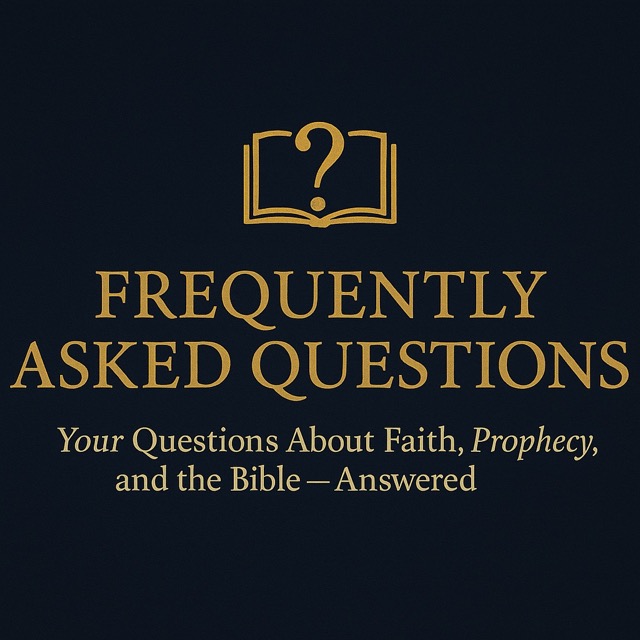
❓ Questions About the Prophecies of Jesus’ Resurrection
🔹 Did the Jews expect a resurrected Messiah?
Not generally. Most Jewish expectations focused on a conquering, reigning Messiah who would overthrow Rome and restore Israel. While belief in a final resurrection (Daniel 12:2) was common among Pharisees, the idea of a single man rising from the dead before the end of time — especially the suffering Messiah — was unexpected.
Yet Jesus Himself said:
“Was it not necessary that the Christ should suffer these things and enter into His glory?”
— Luke 24:26
He reframed their view using Scripture itself, revealing that suffering and resurrection were always part of the plan.
🔹 How is Jonah a prophecy of Jesus?
Jesus directly called Jonah’s experience “the sign” that would confirm His identity:
“Just as Jonah was in the belly of the great fish three days and three nights, so will the Son of Man be in the heart of the earth.”
— Matthew 12:40
Jonah’s descent into watery death and miraculous return is a type — a living metaphor — that points to Jesus’ burial and resurrection. Jesus didn’t just fulfill a verse — He fulfilled a pattern.
🔹 Are these resurrection prophecies symbolic or literal?
Some verses, like Isaiah 25:8 (“He will swallow up death forever”), use poetic language. Others, like Psalm 16:10 and Hosea 6:2, carry dual meaning — symbolic on one level, literal on another. But the New Testament authors interpret them literally when applied to Jesus. For them, Jesus didn’t rise in metaphor — He rose in body and glory, just as Scripture foretold.
🔹 Did early Christians twist Old Testament verses?
It’s a fair question — but the answer is no. Jesus opened His disciples’ eyes to see how the Law, Prophets, and Psalms spoke of Him:
“Then He opened their minds to understand the Scriptures…”
— Luke 24:45
The apostles weren’t inventing connections. They were following Jesus’ own teaching, uncovering truths that were always there — just hidden in plain sight until the Resurrection lit them up.

